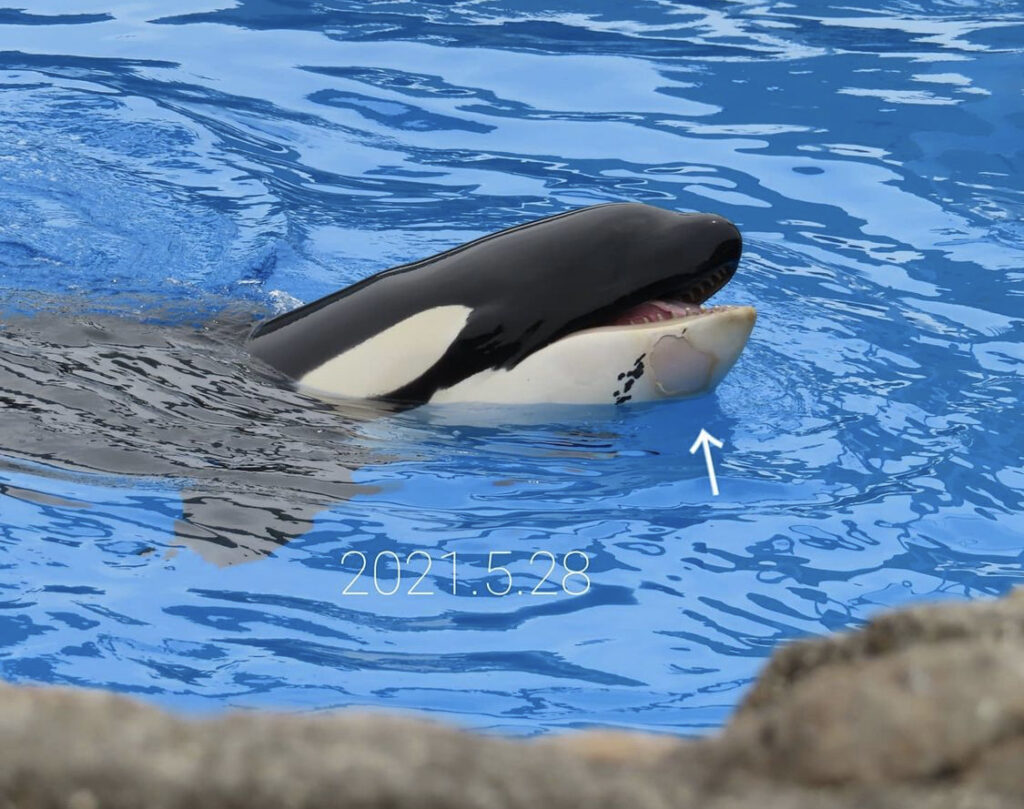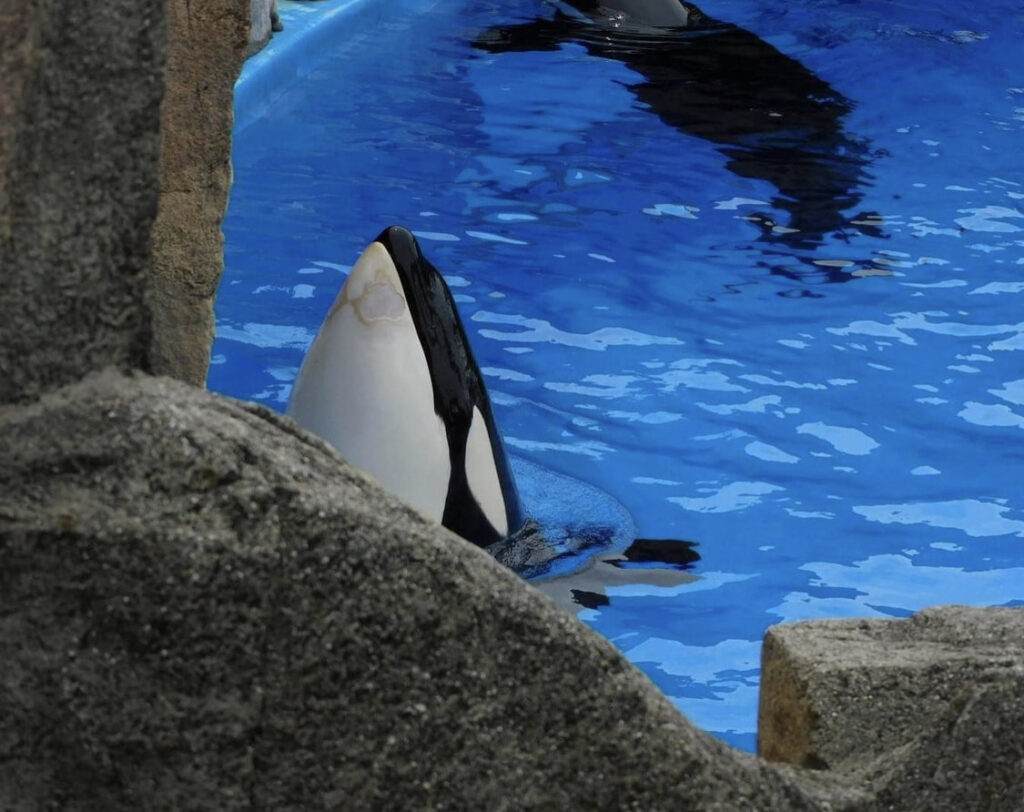December 22, 2021:
Marineland has been charged for violating Canada’s criminal code, more specifically the Ending the Captivity of Whales and Dolphins Act, which prohibits the use of captive dolphins and whales in performances for entertainment purposes. Throughout the month of August, Marineland’s dolphins were observed “doing flips, spinning, having a dolphin dance party and performing other tricks on command to music in front of a live audience”, in direct violation of the law. Marineland claims these behaviours are exhibited in ocean environments (an outright lie) and combined with an educational script. The marine park is due in court in February next year.
Interestingly, Marineland recently received a request from the Whale Sanctuary Project for the park’s solitary orca, Kiska, and up to eight of its beluga whales, to live in its proposed sanctuary in Nova Scotia. While the Whale Sanctuary Project is no means ready to house these animals as of yet, Marineland did say it has “no ideological objection to whales moving to the Whale Sanctuary Project or any facility that meets the required standards of care under Canadian Law”.
It’s quite promising to know that Marineland wouldn’t object to handing some of their animals over to the sanctuary once it’s ready to house residents. News of this charge against Marineland is equally as promising, as it means Canadian law enforcement is prepared to take the Ending the Captivity of Whales and Dolphins Act seriously.
There may be a brighter future for Marineland’s animals. We just need to keep the pressure up!
December 20, 2021:
Tragedy strikes Miami Seaquarium once again. Catalina, a Pacific white-sided dolphin who performed alongside the orca Lolita, died earlier this month. Seaquarium staff suspect that Catalina’s cause of death may have been trauma after having a physical altercation with Lolita and another white-sided dolphin named Li’i. Chasing, white-water and aggression between Lolita and the two white-sided dolphins was observed and reported to be of concern.
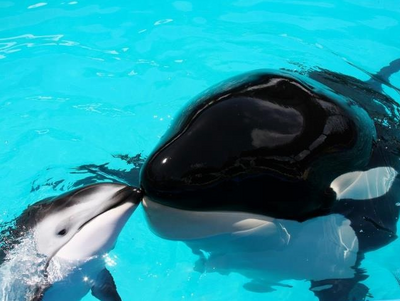
Catalina was born on September 5th, 1993, at SeaWorld San Antonio. Her mother was Lorelai and she was sired by Jump-Jump. In 1999, Catalina gave birth to her first calf, Avalon, who was sired by her own father, Jump-Jump. In 2009, she gave birth to her second calf, Bolt. In early May of 2018, Catalina was taken from her calves and transported to Miami Seaquarium on loan where she would reside with the infamous orca Lolita as well as other white-sided dolphins. On December 3rd, 2021, Catalina was transferred to SeaWorld Orlando for emergency treatment but tragically died there sometime between December 3rd-8th.
Miami Seaquarium has an unfortunate history of housing incompatible animals together. In late August of 2021, a USDA federal investigation report citing Seaquarium revealed a number of horrendous findings, one being that they kept incompatible animals together which led to the deaths of two bottlenose dolphins. Even Lolita, Seaquarium’s sole orca, has a gruesome history of being kept with incompatible tank mates. She is suspected to be responsible for the deaths of two Pacific white-sided dolphins prior to Catalina’s incident, Maki in 2004 and Liko in 2015. (@bornto.bewild)
December 16, 2021:
Do you recall the infamous Russian “whale jail” from 2018?
The Whale Sanctuary Project worked with the Russian government and Russian animal protection groups to return to the ocean 10 orcas and 87 beluga whales who had been captured illegally for sale to marine entertainment parks in China.
In November 2019 the last beluga whales were released, and now the whale jail itself has been completely dismantled and turned into a shipyard.
In a statement from the environmental prosecutor’s office of the Amur Basin — in the Russian Far East, “In order to prevent the illegal keeping of sea animals, the floating structures were dismantled.” The structure of the jail had been moved to a shipyard “in a condition that excludes the possibility of their use for their intended purpose.”
The infamous whale jail of Srednyaya Bay in Russia’s Far East is now a thing of the past, encouraging progress towards the closure of any facility that supports and enables the captivity of these intelligent and socially complex animals.
December 6, 2021:
New information brought to light at this year’s IAAAM virtual conference has revealed that Tekoa suffered a rib fracture when he was 17-years-old, and then suffered a second rib fracture 18 months later, as revealed by successive ultrasounds.
Now 21-years-old, Tekoa is one of five killer whales held at Loro Parque in Tenerife, Spain. He was first sent to the park on breeding loan from SeaWorld as a five-year-old calf, alongside 2-year-old Skyla, 3-year-old Kohana and 10-year-old Keto. Noticeably, the group of young orcas lacked a mature, dominant female capable of establishing a stable social hierarchy. As a result, young Tekoa, who has a very gentle and submissive personality, was brutalised by the other whales.
In 2009, Brian Rokeach, then SeaWorld’s supervising trainer at Loro Parque, had become so concerned about Tekoa that he urged SeaWorld management to transfer him back to the United States, but his pleas were ignored. In 2011, Tekoa was photographed with extremely extensive, prolific rake marks (scratches caused by another orca dragging its teeth along his skin) covering much of his body—he was still being routinely bullied by the other whales despite spending five years at Loro Parque at this point.
While the cause of the rib fractures hasn’t been determined, it’s likely aggression towards Tekoa played a role. Being routinely rammed, slapped, bitten and raked by other several-thousand-pound animals is likely to end in injury, which could’ve been how Tekoa sustained his rib fractures. While it’s believed Loro Parque’s social hierarchy has somewhat improved in recent years, it’s sad to think Tekoa may have still be struggling with aggression as late as 2017/2018. The tight bonds between a family pod would usually prevent serious violence towards one another, but Loro Parque’s artificial pod has long struggled without these established bonds and more submissive whales like Tekoa have suffered the consequences.
December 1, 2021:
@OneVoiceAnimal, an animal welfare organisation, has filed an animal cruelty complaint against Marineland Antibes in France. The complaint concerns the alleged deteriorating health of 10-year-old Moana, one of the park’s four remaining orcas. Over the course of the past year, Moana has been photographed with discolouration across his chin – something killer whale expert Dr. Ingrid Visser and marine mammal veterinarian Dr. Pierre Gallego believes is sub-dermal tissue damage. His condition has only worsened over time, which could be in part due to poor water quality at the facility. Moana’s uncle, 22-year-old Inouk, suffered similar subdermal tissue damage in 2020, although the cause is unknown.
Concerningly, Dr. Gallego believes “Moana’s state of health is critical, and requires urgent treatment by a veterinarian. The pathological process which Moana seems to be a victim of is likely to put his life in danger,” yet, despite the severity of his condition, Marineland have failed to treat Moana effectively or improve his living conditions. Alongside filing their complaint, One Voice has requested an independent investigation and a precautionary foreclosure, which means a ban on transportation of Moana and using him in shows – if granted, the foreclosure would protect Moana from being transferred to China, which, while unconfirmed, appears to be a looming possibility.
November 18, 2021:
Earlier today, the French Senate voted overwhelmingly in favour of a new animal rights bill that will effectively phase out cetacean captivity within the country, with 332 for and 1 against! Once signed by President Emmanuel Macron, it will completely modernise French Animal Welfare laws, making the following changes:
– Bans the breeding and importation of captive dolphins and killer whales
– Bans live dolphin shows for entertainment purposes (to be phased out within the next five years)
– Bans the practice of using wild animals (such as bears, lions and tigers) being used in travelling circuses and live circus shows.
– Bans the use of wild animals in television shows, nightclubs and private parties
– Bans and immediately ends fur farming, meaning the country’s last mink operator will close.
– Bans the display and sale of puppies and kittens from glass cases in animal shops from January 1, 2024.
– Raises the maximum penalty for mistreating animals from a fine to up to five years in prison AND a fine of £75,000.
– Tightens restrictions on the sale of pets, requiring owners to sign a document acknowledging their responsibilities.
– Those who have been convicted of animal cruelty will be added to a list and banned from owning another animal.
These changes are incredibly positive but, as always, improvements still need to be made to change laws regarding foie gras farming, bullfighting and hunting.
In regards to articles impacting wild animals currently held captive in France, the government will set aside a budget of 8 million euros to support the retraining of circus and dolphinarium staff for different careers. The government will also consider how to best place former performing animals, and will provide help for sanctuaries – it’s hoped this will avoid France’s captive cetaceans from simply being exported to a country that allows display for entertainment.
November 7, 2021:
Three months after the death of 2-year-old Ula at Loro Parque, we finally know her cause of death: intestinal torsion/volvulus (twisted intestines). Skyla, who died back in March, also died from intestinal torsion. The information comes not from Loro Parque directly, but from a new short documentary released by Zembala (Morgan, de verloren orka – deel 2 – Zembla – BNNVARA), in which a Loro Parque vet confirms the cause of death. Ula had been suffering from intestinal issues since April and in the weeks leading up to her death appeared severely ill and noticeably underweight.
Since Ula’s death on August 10, Loro Parque has failed to mention her since, only doing so very briefly in blog posts attacking animal welfare groups. The way Loro Parque is now ignoring Ula’s existence, while disappointing and disgusting, is not surprising. Besides Skyla and Victoria (two orcas – high profile animals), the deaths of several bottlenose dolphins (Blue, Robin, César), and a sea lion (Olivia) were never announced by Loro Parque. Instead, the existence of these animals was concealed and ignored. No longer able to exploit them for profit, Loro Parque no longer cares for them. They all deserved better. (@end__speciesism)
November 4, 2021:
Cookie, a 9-year-old orca held at Shanghai Haichang Ocean Park in China, reportedly gave birth to a live calf on September 9th, 2021, as confirmed by Dr. Naomi Rose and the China Cetacean Alliance during a recent webinar. According to the CCA, Cookie struggled to establish a bond with the calf – which may have been a result of being disturbed by staff / onlookers – and then failed to effectively nurse the calf within the first 24 hours, prompting staff to separate the pair. Now having to be hand-reared by inexperienced trainers and fed an artificial formula, it’s highly unlikely the calf will survive. Unfortunately, there are no photos or videos of the calf so it’s difficult to confirm if it’s still alive.
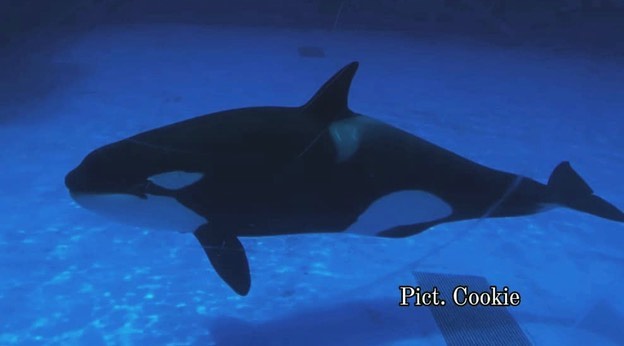
The birth of a calf is not entirely surprising. For months prior to the birth there was great speculation that Cookie was pregnant. She had been taken out of shows for several months and appeared much rounder than the other whales, despite being the youngest and smallest orca at the park. Photos taken in September also show Cookie with a rather swollen abdomen / mammary area, suggesting she may have given birth recently. The behaviour of Cookie’s tank mates may have also provided an indicator that she was pregnant. Back in August footage was captured of Dora and Dylan harassing Cookie, appearing very interested in her lower abdomen / genital area. Captive orcas have been observed pressing their rostrums against the lower abdomen area of pregnant females as if they’re “checking” on the unborn calf. It’s possible Dora and Dylan knew Cookie was pregnant which is why they focused on this area of her body, although she appeared to find this sudden attention rather overwhelming and even hit her head on the bottom of the tank trying to avoid them.
News of a calf born in China is equally disheartening and concerning but this is just the beginning. More calves and reproductive failures are likely to follow in China’s bid to profit off performing orca.
October 19, 2021:
Last month PETA obtained federal records from NOAA that revealed six marine mammal deaths, five bottlenose dolphins and a juvenile California sea lion, at Miami Seaquarium from 2019-2020.
Two dolphins, Indigo and Echo, and a juvenile sea lion, that did not yet have a name, died from trauma to the head and neck. A third dolphin, Abaco, drowned after getting caught in a net that was in the tank. Another dolphin died from an unexplained gas embolism in the liver and the fifth dolphin died from “multiple developmental anomalies”.
The number of deaths alarmed a NOAA Fisheries Services scientist, who notified the U.S. Department of Agriculture (USDA) about the pattern of trauma-related deaths at Miami Seaquarium. PETA is now asking the park to release full necropsy reports and any relevant behavioral records to the public. PETA has also requested additional records from the USDA, who have not cited the Miami Seaquarium over the deaths, even though NOAA alerted the agency to the pattern of trauma-related fatalities.
In this last month, Miami Seaquarium has repeatedly been exposed for their history animal welfare violations that have lead to the death of their marine life. To this day, their negligence is killing marine mammals. They need to be held accountable. Don’t support Miami Seaquarium. Don’t buy a ticket!
October 12, 2021:
Russia has officially begun the legal process of banning the capture of whales, dolphins and porpoises for commercial purposes! IF combined with a ban on captures for educational and cultural purposes, this could ensure the inhumane, completely profit-driven MESS that was “The Whale Jail”, Will. Never. Happen. Again!
Between the months of July-October of 2018 in the Okhotsk Sea along the east coast of Russia, 11 orca and 90 Beluga were captured and held in a series of small indoor/outdoor pens, 7,000km from Moscow. Each was intended for selling to Aquariums in China, for a sum of over $68 million dollars. Over a year later, due to worldwide public outcry and advocacy, 10 orcas and 87 belugas, were finally set free near the areas of their capture.
It’s important to note captures could still occur under permits issued for “educational and cultural purposes” unless a subsequent ban targeting these clauses is introduced. We must keep the pressure up until Russia does the right thing outright! (@orcarescues)
October 2, 2021:
BREAKING: A new U.S. Department of Agriculture inspection report cites Miami Seaquarium for repeatedly acting AGAINST veterinarians’ instructions.
PETA has just uncovered a damning new 17-page federal inspection report revealing a slew of animal welfare violations at Miami Seaquarium, including that it repeatedly acted against veterinarians’ instructions; housed incompatible animals together, leading to injuries and two bottlenose dolphins’ deaths; and failed to provide the orca Lolita and several other animals with sufficient shade, leaving them in direct sunlight, which can cause painful damage to their eyes.
According to the newly released June 8 report, the Seaquarium went against veterinarians’ instructions when it repeatedly fed marine mammals poor-quality, foul-smelling fish; reduced Lolita’s food intake; kept forcing her to perform tricks that had likely injured her jaw; and, despite documented aggression among Lolita and the two Pacific white-sided dolphins already held with her, planned to move two more Pacific white-sided dolphins into the same tank.
The report also notes that visitors held cell phones, cameras, and even small children over the metal barrier surrounding the tank holding Lolita, placing both her and visitors at risk. Injuriously high levels of chlorine and parasites were measured in the pools, and numerous tanks were in various states of disrepair. One underwater fence was merely zip-tied together, and two dolphins broke through into an adjacent tank and apparently attacked another dolphin, inflicting at least four broken ribs.
More to come! (@untillolitaishome)
August 19, 2021:
Third captive killer whale dies this year. Amaya, the youngest orca at SeaWorld San Diego being just 6 years old, has died. She “suddenly” showed signed of illness on August 18 and perished the following day.
Amaya was born on December 2nd, 2014, to Kalia and Ulises at SeaWorld San Diego, and was the youngest of SeaWorld’s orcas. From a very young age, Amaya had an energetic and playful personality and would often be seen playing with her uncle Makani. In recent times, she spent most of her time with her mother, Kalia, and Shouka, who took on a caregiver role.
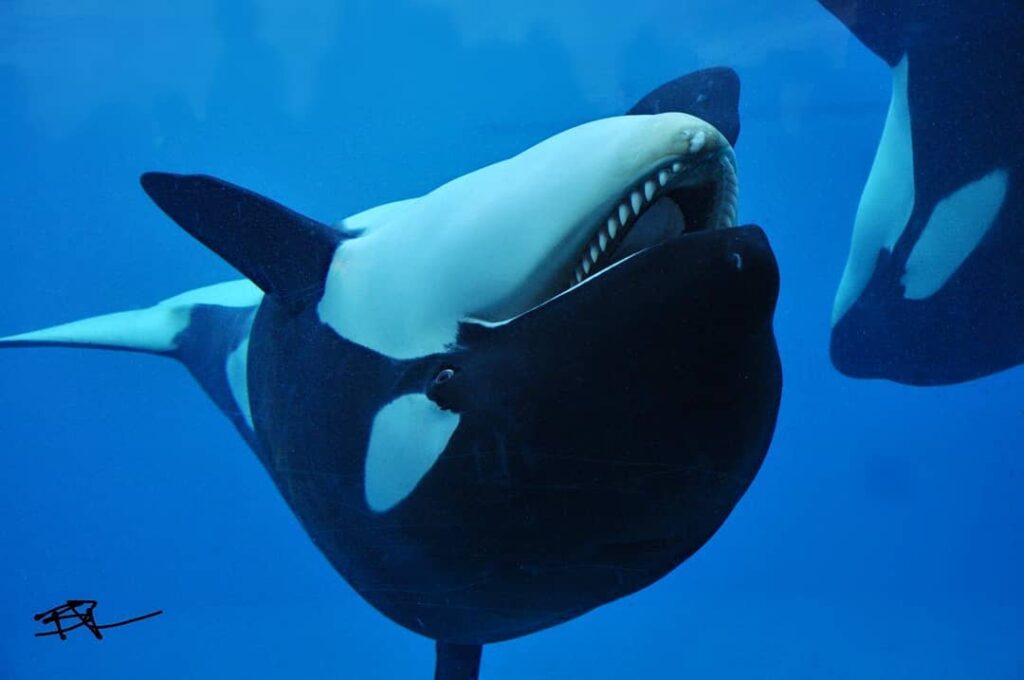
Amaya’s death comes just a number of days after 2-year-old Ula died at Loro Parque, possibly from an intestinal condition (according to LP), and 17-year-old Skyla died in March from “intestinal torsion.” Ula was born to Morgan, a once-wild killer whale who was rescued as a calf and condemned to a life in captivity where she was, and continues to be, attacked by her fellow tankmates. Skyla was separated from her mother by SeaWorld Orlando when she was just two years old to be sent to Loro Parque on a breeding loan.
At least one killer whale has died in captivity every single year since the 1970s. It is only August and we have lost three already in 2021 alone… (@sevenseasoffreedom / @end__speciesism)
August 10, 2021
Loro Parque has announced the tragic death of Ula, their 2-year-old orca calf. The park had stated just a few days ago that they had noticed Ula’s behaviour had started to deteriorate, and were running tests to determine the cause. Unfortunately, Ula succumbed to her illness earlier today. While Loro Parque claim Ula first showed signs of illness a few days ago, recent photos documenting Ula’s body condition over the past few weeks show she had lost a concerning amount of weight, with the outline of her skull and numerous ribs clearly visible.
Ula was born on September 22nd, 2018, to Norweigian female Morgan and captive-born male Keto. Ula had a rocky start to life and had to be separated from Morgan just a few days after her birth due to Morgan’s “low milk production”, as Loro Parque claimed. After 15 weeks of separation, mother and daughter were reunited.
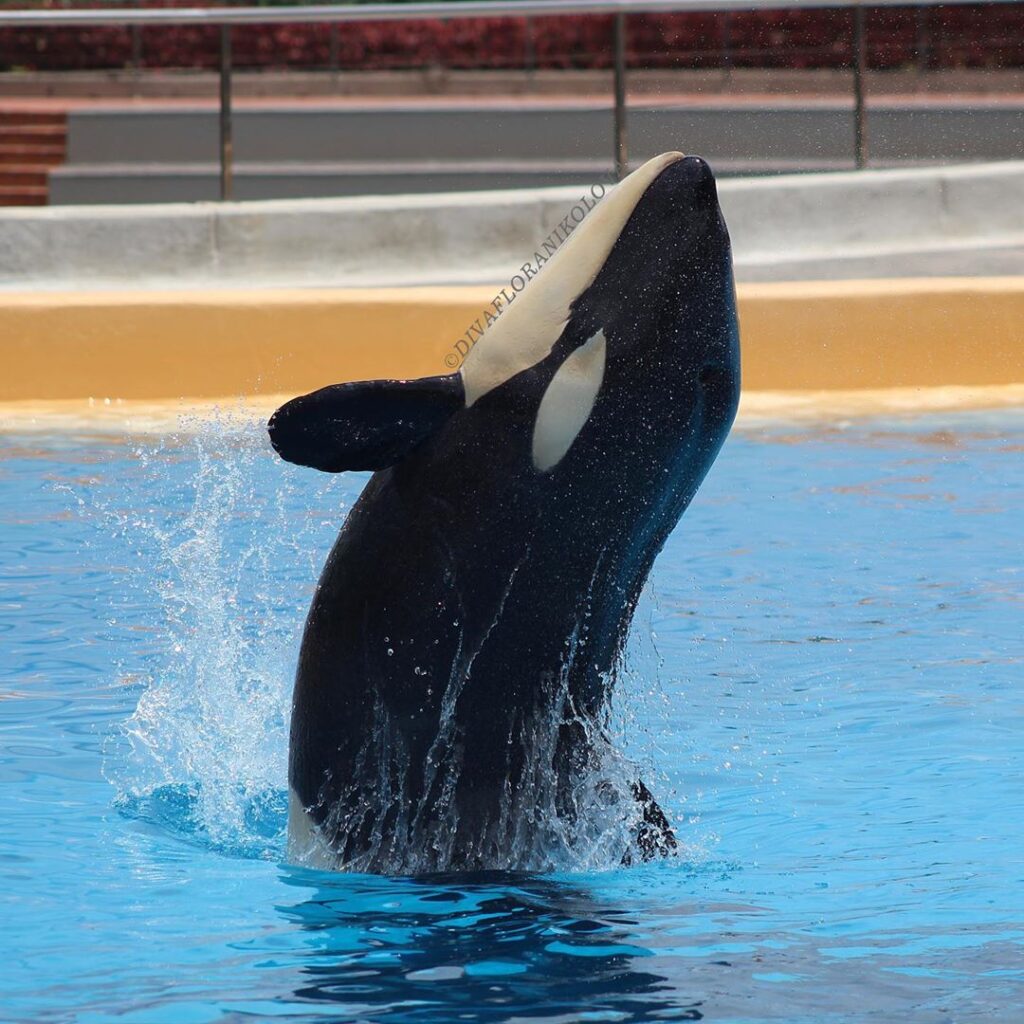
Shortly after the reunion, Ula appeared to be ill with a deformed pectoral fin. Loro Parque at first denied this but later confirmed that Ula was sick and injured, however, she was able to recover. In the spring of this year, Loro Parque announced Ula was sick once again, but insisted that she had greatly improved a matter of weeks later. Sadly, that proved not to be the case as little Ula passed away earlier today.
Rest In Peace, Ula. ❤️
Ula’s death is the second death to occur at Loro Parque in less than 6 months. On March 11th, 2021, Skyla died at the facility at 17-years-old from intestinal torsion and septicemia. These whales deserve better. #CaptivityKills
July 29, 2021:
Marineland Canada is facing a legal complaint following viral videos exposing the plight of Kiska, the park’s solitary orca. Filed by Animal Justice, an animal law non-profit group, the complaint alleges Marineland’s treatment of Kiska breaks the law as her current conditions fail to meet her physical and mental needs.
Despite the fact orcas are extremely social animals with complex hierarchies and strong bonds, Marineland has housed Kiska in solitary confinement since 2011, completely disregarding her need for social interaction for almost 10 years. While two other captive orcas are currently housed in isolation from their own species, Kiska is unique for the fact that she’s not just housed without another orca, but housed without any animal companions at all. She’s simply been left alone in her small, dirty tank for almost 10 years, to swim circles or log listlessly while stricken with intense loneliness.
Marineland’s treatment of Kiska arguably violates two laws: the Provincial Animal Welfare Services Act, which states an animal’s owner cannot cause or permit distress, and the Criminal Code, which prohibits anyone to wilfully cause or permit suffering or neglect, but it will be down to the Ontario government to investigate further.
Marineland is already in hot water with the local government for failing to repair and maintain its water systems which was determined by Ontario’s Animal Welfare Services to have caused distress to animals at the park. Hopefully Animal Justice’s complaint is taken seriously given Marineland’s history, and action is taken to put an end to the park’s abhorrent treatment of Kiska.
July 23, 2021:
Devastated to announce the death of Toa, the killer whale calf who stranded in New Zealand nearly two weeks ago. Despite the efforts of dedicated volunteers and international vets, Toa passed away last night shortly after being returned to his sea pen (he had been temporarily moved to a landside pool due to bad weather). He deteriorated very rapidly after having relatively minor health concerns over the past few days (lethargy, scrapes from his stranding and an inflamed eye).

A necropsy will not be performed out of respect for Ngãti Toa Rangatira, a local Mãori tribe who has been involved with Toa’s rescue since the beginning. Instead, they have taken his body for burial after the appropriate ceremony. While it’s unfortunate we’ll never know for sure what caused Toa’s death, it’s vitally important to respect the culture and traditions of New Zealand’s indigenous people. Please keep those who fought so hard to try and return Toa to his family in your thoughts during this difficult time. 💔
July 14, 2021:
The killer whale calf who was stranded on a beach in New Zealand a couple days ago has yet to be reunited with his family. There have been a few killer whale pod sightings since his rescue but unfortunately none have been confirmed to be his family pod. However, there are a few positives that the rescue teams caring for him have shared over the last few days. The calf is a male and has been named “Toa”, meaning strong or brave in Māori. He is estimated to be around 4-6 months old.
On Sunday, a boat ramp at a dock was closed off to make a small temporary sea pen for Toa. He is under 24hr watch by the rescue teams and volunteers. He has been examined by vets and orca researchers. They found he was in good health and have developed a milk formula to help Toa get the nuriments that are critical for him to receive at his young age. Whale-Rescue.org recently reported that all is going well for Toa. He is getting rest and has had a few bowel movements which indicates that he has accepted the milk formula.
More locals and organizations, such as helicopter operators and zoos, have gotten involved with Toa’s rescue. Interestingly, Loro Parque, a zoo in Tenerife, has reached out to Toa’s rescue team and offered their assistance. Loro Parque owns six killer whales and several bottlenose dolphins. Ingrid Visser, a killer whale researcher and the head of Toa’s rescue operation, is strictly against whales and dolphins in captivity. However, this is a unique situation and it’s possible both parties will put their differences aside to improve Toa’s chances of survival.
If anyone in the Wellington area spots killer whales please call 0800 733 6722 immediately.
July 11, 2021:
Yesterday, a killer whale calf was separated from its pod and found stranded at Plimmerton beach north of Wellington, New Zealand. The Department of Conservation, Whale-Rescue.org and Project Jonah were all present to assist the stranded baby killer whale.
Ian Angus, the manager for the Department of Conservation marine species, has said the following on the situation; “Yesterday evening, we alongside the rescue team had attempted to the baby orca’s pod to return it safely to it’s family. Unfortunately, we have not been successful in locating the pod. Overnight, to keep the calf safe, the rescue team loaded the calf onto a trailer where it will be kept onshore, actively monitored by Whale-Rescue.org and kept moist and cool overnight.” Today, the search for the killer whale’s family pod will resume. Until the pod has been located, the calf will continue to be cared for by the department and rescue teams.
The department has requested that if anyone in the Wellington area spots killer whales to please call 0800 DOC HOT immediately.
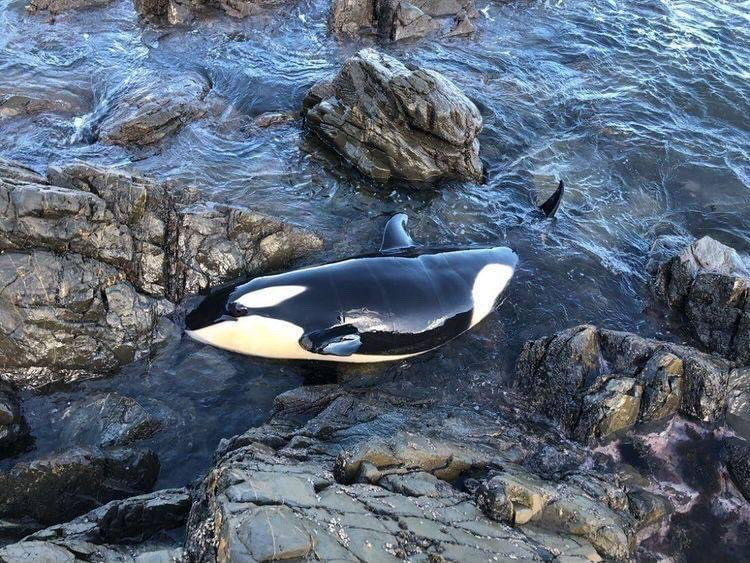
June 2, 2021:
In an open letter to PETA, Loro Parque have stated Ula is back to full health and no longer suffering from the intestinal disease that has been afflicting her for the past few weeks.
June 1, 2021:
A worrisome update on Lynn, Port of Nagoya Public Aquarium’s 8-year-old killer whale. Recent images posted by an aquarium visitor show Lynn with two large circular lesions on her lower jaw. A little over a week ago, there was growing concern for Lynn and her mother Stella because the pair had been isolated to the aquarium’s medical pool and were absent from shows. When a trainer was questioned about this, they revealed that Lynn was ill.
A few days later, both Lynn and Stella were released from the medical pool and started performing high-energy behaviours in the back pools, such as leaping out of the water, sparking hope that Lynn’s health had improved. However, recent photos suggest otherwise.
According to what visitors have said, the lesions first started off as slight discoloration or odd bruising, but rapidly began to get larger and started to peel. Unfortunately, Port of Nagoya Public Aquarium has still not made an official announcement about Lynn’s health. What exactly she is sick with, why her skin is reacting the way it is, or how severe her condition may or may not be is unknown.


Photos by Koro_610 (IG) 
May 24, 2021:
Lynn, an 8-year-old killer whale who currently resides at Port of Nagoya Public Aquarium in Japan, is sick. According to park guests, Lynn and her mother Stella have been absent from shows for a while now. Instead, the pair has been frequently seen in the medical pool. When a trainer was questioned about what is going with the two killer whales, they revealed that Lynn appears to be ill. Port of Nagoya Public Aquarium has yet to release an official statement on the situation so unfortunately very little is known about Lynn’s condition. Hopefully she recovers quickly!
May 8, 2021:
Loro Parque have provided another update on Ula sparking cautious optimism for her recovery. It reads:
“We are happy to share with you that Ula’s health continues to improve, although the veterinary team is still very cautious and considers that it will take several weeks before her problem is fully resolved. On the ultrasound scans performed several times a day, there are still perceived signs of inflammation and intestinal distension, although already remitting, and for the past several days other, more worrying symptoms have no longer been detected.
In addition to the medical treatment that she has been receiving in the past weeks, the veterinary team has established a strict diet to ensure the recovery of her digestive system. This, as expected, has produced some weight loss, although special care has been exerted to maintain her proper hydration. In the coming weeks, the nutrition will be introduced gradually to verify that her digestive system can tolerate and process it properly.
Ula has recovered her spirits, her interest and the desire to play, like any calf. Her trainers and veterinarians are confident that her character and strength will help her to overcome this situation completely.”
May 2, 2021:
Loro Parque have provided an update on Ula, their 2-year-old orca calf who is currently suffering from intestinal issues. Ula’s mood is said to have improved in recent days and she is voluntarily participating in medical procedures which is a positive development. She’s also been sighted interacting with trainers and playing with Environmental Enrichment Devices (EEDs) by visitors who attended Loro Parque’s re-opening.
Unfortunately, Ula’s physical condition has deteriorated and she’s lost some weight but Loro Parque remain optimistic about her recovery, although they admit it’s too early to say she’s out of danger yet.
Another update will be provided in a week’s time.
Get well soon, Ula!
April 29, 2021:
A recent article by Xinmin Evening News has finally revealed the names of Shanghai Haichang Ocean Park’s four killer whales almost two-and-a-half years after their first debut in November 2018.
The four names are as follows:
胖虎 “Fat Tiger” – Also known as Dillon / Dylan.
Sex: Male
Age: 12 years old
Misc. Largest of the four whales.
朵拉 “Dora”
Sex: Female
Age: 9 years old
饼干 “Cookie”
Sex: Female
Age: 8 years old
Misc. Considered the most dominant female at park despite her young age.
肖恩 “Sean”
Sex: Male
Age: 8 years old
Misc. Young and submissive. Frequently bullied by the other whales and often isolated in the back pools.
All four of these whales were captured from Russia’s Sea of Okhotsk in 2015. Kidnapped from their pods and stolen from their ocean homes, Dylan, Dora, Cookie and Sean will now live and die in Shanghai Haichang Ocean Park’s barren, cramped pools, performing the same show over and over again until their bodies give out. That’s no life to live. Please help put an end to this cruelty. Spread awareness and, for their sake, don’t buy a ticket.
April 27, 2021:
Positive news! Progressive step forward towards a permanent ban in wild dolphin and whale captures in Russian waters.
Russia’s Deputy Prime Minister Viktoria Abramchenko confirmed earlier this week that the government has prepared amendments to a draft Federal law to permanently ban the capture of wild cetaceans.
The authorities are planning stricter regulations with regards to cetacean captures in Russia’s exclusive economic zone 200 nautical miles from its shores – establishing a permanent ban on the export of wild cetaceans at Eurasian Economic Union level (states located in Eastern Europe, Western Asia, and Central Asia).
Ms Abramchenko has stated that the protection of cetaceans and other marine species is a priority of Russia’s environmental commitment to the country, and the updated draft has been approved by a government commission on the legislation amendments which are to be presented at the cabinet’s meeting within two weeks.
This is a huge step forward in the fight to ban cetacean captures in the country and, with final approval, would globally erase live-capture fisheries for orcas and beluga whales. Wild animals do not exist for our entertainment. It appears that message is finally getting across!
April 24, 2021:
Ula, Loro Parque’s 2-year-old killer whale, is sick. The park detailed in a blog post that Ula’s mood has been deteriorating over the past few days and continues to decline. She appears to be showing signs of an intestinal problem, but all tests conducted so far have come back inconclusive, including a blood test that ruled out any signs of infection. The park also noted that Ula has been separated from the rest of the pod and placed into the medical pool for treatment.
News regarding Ula’s poor health follows the death of 17-year-old Skyla who died at the park just last month. Skyla reportedly fell ill suddenly, much like Ula, and later died from gastric torsion and septicaemia.
Let’s hope Loro Parque’s veterinary team are able to treat Ula and she makes a full recovery. 🤞
March 15, 2021:
Loro Parque has shared the necropsy results of Skyla, their 17-year-old killer whale who died on March 11th. Needless to say, the findings are of high concern. Here’s Loro Parque’s statement:
“According to the results of the necropsy, the cause of death was intestinal torsion, which caused acute septicemia and immediate death. This pathology can occur suddenly in completely healthy animals and is absolutely inoperable in cetaceans, so, despite all our precautions and efforts, it would not have been possible to do anything to save Skyla’s life.“
Intestinal torsion, also known as volvulus, “is when a loop of intestine twists around itself and the mesentery that supports it, resulting in a bowel obstruction.” The symptoms of volvulus include bloody stool, abdominal pain, abdominal bloating, and vomiting. Loro Parque’s first statement on Skyla’s death was that she showed some signs of discomfort. However, looking at the symptoms that intestinal torsion causes, Skyla’s death would have been an excruciatingly painful one.
Loro Parque added that the intestinal torsion led to acute septicemia. This is the same exact blood infection that killed Skyla’s mother, Kalina, 10 years ago at SeaWorld Orlando.
March 12, 2021:
Devastating news from Loro Parque. Skyla, one of the park’s four female killer whales, died suddenly last night after showing signs of discomfort. The park claims Skyla was in perfect health prior to the onset of her symptoms. She was just 17 years old.
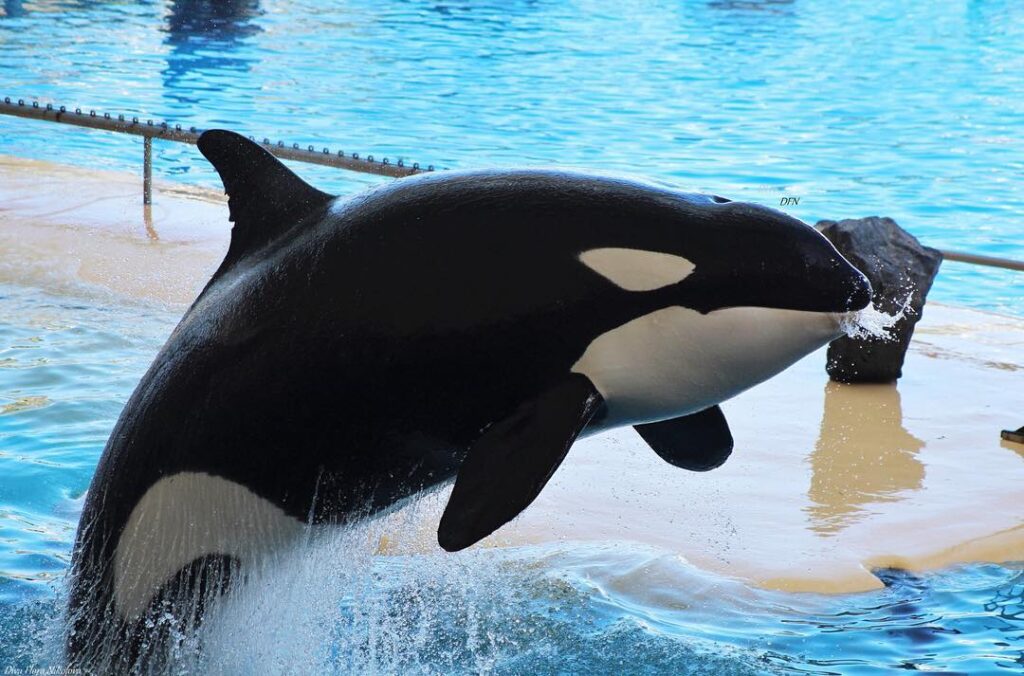
Skyla was born at SeaWorld Orlando, Florida, on February 9th, 2004, to devoted mother, Kalina, and father, Tilikum. Sadly, Skyla was torn from her mother’s side at just two years old and sent across the world on breeding loan to Loro Parque in Tenerife, Spain. On the day of the separation, as Skyla was being harnessed and craned out of the pool, her mother, Kalina, became incredibly distraught and began ramming into the gate separating her from her daughter. Her relentless attempts caused her to ‘break open her face’ resulting in significant lacerations. Sadly, Kalina’s distress was ignored and the transfer went ahead. The pair never saw each other again.
At Loro Parque, Skyla was joined by three other young SeaWorld orcas (3-year-old Kohana, 5-year-old Tekoa, and 10-year-old Keto) who had suffered similar treatment. However, the grouping of four young whales quickly presented a problem in terms of social structure as the group lacked an older, dominant matriarch, and still does. This led to aggression issues between the whales, and sometimes aggression towards trainers.
While Skyla maintained a more dominant role within the group, she spent much of her life in what’s been described as the most dysfunctional orca pod in captivity. She deserved a life alongside her mother and siblings, in an environment that could stimulate her mind and intrigue her senses, not one of intense deprivation in a concrete tank. Rest in peace, Skyla. You deserved so much better.
January 16, 2021:
SeaWorld Orlando’s pod of orcas have been reunited after being separated into same sex groups in February/March last year.
| 1997 | 1998 | 1999 | 2000 | 2001 | 2002 | 2003 | 2004 | 2005 | 2006 | 2007 | 2008 |
| 2009 | 2010 | 2011 | 2012 | 2013 | 2014 | 2015 | 2016 | 2017 | 2018 | 2019 | 2020 |
| 2021 | 2022 |
